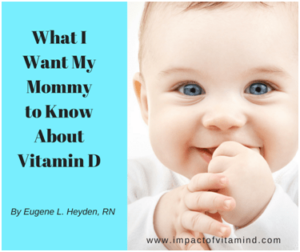What Will Happen to Me if I Don’t Get Enough Vitamin D?

Last update: 08-26-22
By Eugene L. Heyden, RN
I actually hate to tell the little guy. It seems like I’m always dwelling on the negative. But since he wants to know, I think I should tell him. I owe it to him to be honest. And he looks a little worried at the moment, don’t you think? Did I mention his name is Jimmy?
Well, little Jimmy, sadly, you are at risk for some very bad things. Type 1 diabetes is a bad thing. Crohn’s disease is a bad thing. Multiple sclerosis is a bad thing. Soon, you will learn that a spanking is a bad thing. (I can’t help you there.)
I know, I can’t shield you from every evil, but I may be able to shield you from some. However, it won’t really be me. More likely, it will be your mom or your dad, or both, who will be setting in motion something so powerful that it can shield you from the evils of which I speak. What I hope for you, little Jimmy, is that all the major players in your life—Mom, Dad, and the exceptional physician who is watching over you—will recognize the dangers of vitamin D deficiency and do what it takes to make and keep you vitamin D sufficient. But apparently not everybody (exceptional physicians included) is recognizing the dangers and acting to eliminate the problem.
“In the United States, it is estimated that 50% of Children 1–5 years and 70% of children age 6–11 years are vitamin D deficient or insufficient. This has potentially serious consequences.” (Holick, 2012)
Jimmy, I think it is safe to say that you are probably vitamin D deficient at this very moment—I see no attractive suntan, and I doubt if you will be crawling out from under that blanket anytime soon. And because you are nursing, likely your vitamin D needs are not being met. Breast-fed babies are notoriously vitamin D deficient (Misra et al., 2008). So, unless Mom has a lot of vitamin D on board or you are receiving vitamin D supplementation in relevant amounts, I’m afraid you are headed down the wrong path. The wrong path often starts before birth—vitamin D deficiency is extremely common during gestation and often continues through infancy and beyond. But I’m getting a little ahead of my story. Let’s talk lunch.
No, little Jimmy, there is nothing wrong with Mom. She has the capacity to provide you with generous amounts vitamin D in her breast milk, but most likely she, herself, is vitamin D deficient with little to pass on to you. It takes somewhere between 4,000 to 6,000 IUs of vitamin D each day (or frequent, relevant skin exposure to the sun between 10 AM and 3 PM, late Spring to early Fall) for mothers to be able to pass enough vitamin D along to make their babies vitamin D sufficient (Mulligan et al., 2010; Wagner et al., 2008). I’m sure she would like to get outdoors and have some fun in the sun—and in this manner generate generous amounts of vitamin D for her own needs and to share with you—but, you are filling your diapers so fast and furiously, dealing with this issue alone leaves her little time for anything else. Besides, it’s winter now, a time when little to no vitamin D is created from sunlight exposure no matter how hard one tries (Weydert, 2014). So, as you can see, vitamin D deficiency is so easy to come by. Mom is in danger, too—vitamin D deficiency can harm her as easily as it can harm you. But now my focus is on you. And to be quite honest, I’m a little worried about the parenting advice Mom may have received.
If you listen to those in the dermatology community, they want you to stay under that blanket for at least six months, recommending no sunlight exposure for infants during the first six months of life because they feel that babies’ skin is too sensitive and too vulnerable to damage by the sun’s UV rays (American Academy of Dermatology, 2015). Others in the medical community may recommend that unless vitamin D deficiency is clearly established, “vitamin D supplements should not be provided in early infancy.” (Pérez-López, 2007) And since there is no real push to supplement nursing mothers with thousands of International Units of vitamin D per day (instead of the recommend hundreds of units per day day), is it any wonder the vitamin D deficiency is very common during infancy? In view of all this, what are the consequences?
Infections
Infections occur more frequently in babies who are vitamin D deficient. It is well known that vitamin D is intimately involved in our defense against bacteria and viruses, and a deficiency of vitamin D weakens our immune defenses.
“As early as birth a child is often deficient in vitamin D, which may not only affect their bone metabolism but also modulate their immune function, contributing to the increased susceptibility to many infections seen early in life.” (Battersby et al., 2012)
And consider this:
“Vitamin D deficiency seems to be a risk factor for severe respiratory infection in children <5 years of age.” (Laaksi et al., 2010)
Of course, many infections—pneumonia included—require prompt medical attention. Uh-oh! Here come the antibiotics! And here come the unintended consequences. One study found, “Those receiving one of more dispensations of antibiotics were at a 2.9 times the odds . . . of being an IBD [Crohn’s disease or ulcerative colitis] case.” (Shaw et al., 2010) Surprisingly, this study also found that “individuals diagnosed with pneumonia before 5 years of age were at almost three-fold the odds of developing pediatric CD [Crohn’s disease].” Another study found that Crohn’s disease can occur in as little as three months following several courses of antibiotics (Hviid et al., 2011). So, let’s talk about Crohn’s disease for a few moments.
Crohn’s disease
“Vitamin D deficiency has been linked to several different diseases, including the immune-system diseases ulcerative colitis and Crohn’s disease.” (Cantorna et al., 2004)
“Hildebrand et al. found that individuals diagnosed with pneumonia before 5 years of age were at almost three-fold the odds of developing pediatric CD [Crohn’s disease], compared to those with no recorded pneumonia diagnosis.” (Shaw et at., 2010)
Crohn’s disease affects thousands upon thousands of kids in North America alone. It is a horrible disease. Those suffering with Crohn’s disease experience intense inflammation of the intestinal tract, abdominal pain, and a variety of other symptoms to deal with. The disease can be very difficult to treat, and sometimes the treatments, in and of themselves, can be exceptionally harmful, even deadly. Without question, Crohn’s disease occurs more frequently in those who are vitamin D deficient. And since antibiotics disrupt the normal protective bacteria in the gut, antibiotic use can lead to Crohn’s. So, here we see two ways to become more at risk for developing Crohn’s. Vitamin D deficiency and antibiotic use. Add them both together, and I see trouble ahead. You didn’t know any of this, did you little Jimmy? (Don’t be embarrassed, neither does Mom.) Let’s move on. We need to talk MS.
Multiple sclerosis
“Early life sunlight exposure and dietary vitamin D supplementation diminish the risk of MS [multiple sclerosis].” (Chaudhuri, 2005)
“Higher sun exposure during childhood and early adolescence is associated with a reduced risk of multiple sclerosis.”(van der Mei, et al., 2003)
“Early sun avoidance seems to precede the diagnosis of multiple sclerosis (MS). This protective effect is independent of genetic susceptibility to MS.” (Islam et al., 2007)
Multiple sclerosis (MS) is a disease prompted by vitamin D deficiency. Approximately 200 Americans receive this diagnosis each and every week. In MS, a degeneration of the nerves that control movement and other bodily functions occurs, leading to a whole host of problems to deal with day-in and day-out. It is like being destroyed from within . . . slowly . . . over time. Nobody is particularly excited about the overall success we are having with treating MS. They still call it incurable. The evidence is strong; vitamin D deficiency in childhood and youth—even during gestation—makes it a lot easier to contract this disease. What should be kept in mind is this: a situation or an event occurring during pregnancy, infancy, childhood, or later in life, may set the stage for a disease process to develop years later. This seems to be what is occurring with MS. It also seems to be what is occurring with type 1 diabetes.
Type 1 diabetes
“In a Finnish study, children who received 2000 IU of vitamin D per day during the first year of life had an 80% reduction in the risk of the development of type 1 DM during a follow-up period of 30 years. In contrast, children who were vitamin D-deficient or who were suspected to have rickets at 1 year had a 2.4-fold increased risk of the development of type 1 DM.” (Mulligan et al., 2010, emphasis added)
Type 1 diabetes claims approximately 15,000 new child victims each year. And that’s just in the United States! In the United States, type 1 diabetes chews up about $14.4 billion health care dollars each year with an average annual cost of over $9,000 per child. In this disease, the cells of the immune system attack and progressively destroy the insulin-producing cells of the pancreas. Since insulin is required to allow glucose to enter the cells, with less insulin production the cells of the body are starved of fuel. Without treatment, death occurs. Luckily, we can use injectable insulin to smooth things over. But still, these kids have a lot of health issues to deal with for life.
Did you take notice that the kids in the Finnish study, who became remarkably resistant to contracting type 1 diabetes, received 2,000 IUs of vitamin D . . . in their first year of life?! Say, let’s not learn a thing here and continue to supply little if any vitamin D supplementation to the little Jimmies (and the little Susies) of the world. On second thought, let’s not do that. That would not be right.
So, as you can see, little Jimmy, bad things can happen to you if you don’t get enough vitamin D. I didn’t mean to scare you. But now I do really mean to scare you—you, along with Mom, Dad, and the exceptional physician who is watching over you. There is something perhaps worse than the evils we have discussed thus far. Can little Jimmy say “Schizophrenia?”
Schizophrenia
“In utero or early life vitamin D deficiency has been linked to an increased risk of type 1 diabetes, asthma, and schizophrenia. ” (Bodnar et al., 2007)
“The absence of vitamin D supplementation during infancy was associated with an increased risk of schizophrenia.” (McGrath et al., 2004)
Schizophrenia is a disease of the mind. Thoughts become distorted. Reality can be in short supply. Sometimes it is a nightmare you never wake from. Surprisingly, vitamin D deficiency in early life—a time when the brain is rapidly developing—can lead to a distortion of the structure and an alteration of the function of the brain, giving rise to this unfortunate state of existence. Now this is interesting: The Finnish children who were found to have an 80% less chance of contracting type 1 diabetes if supplemented with 2,000 units of vitamin D per day during their first year of life also had a greatly reduced (77% less) risk of developing schizophrenia, at least in the male subjects of the study. (McGrath et al., 2004). It is still something of a mystery why no females in the study group came down with schizophrenia. It may be that their higher estrogen levels offered them a degree of protection against developing this condition (Cannell, 2008).
Jimmy, I could tell you more, but I need to bring things to a close. I smell something a little funny. It may be your diaper. Once again, I see Mom putting on her nose plugs. So, for obvious reasons, I will bring our little discussion to a close. I won’t take the time to mention your increased risk of ADHD, autism, asthma, allergies, dental cavities, depression, and many other evils that occur more frequently in babies who live the vitamin D deficient life. Word of advice: Jimmy, don’t live the vitamin D deficient life.
“The world is currently facing an unrecognized and untreated pandemic of vitamin D deficiency. Sensitizing pediatricians to recognize and treat this pandemic would have great impact on child health in the 21st century.” (Rathi and Rathi, 2011)
Related Posts (Click image too open)
References
American Academy of Dermatology 2015 The First Steps of Sun Protection: How to Keep Your Baby Safe. https://www.aad.org/media/news-releases/the-first-steps-of-sun-protection-how-to-keep-your-baby-safe
Battersby AJ, Kampmann B, Burl S 2012 Vitamin D in Early Childhood and the
Effects on Immunity to Mycobacterium Tuberculosis. Clinical and Developmental Immunology doi: 10.1155/2012/430972
Bodnar LM, Simhan HN, Powers RW, Frank MP, Cooperstein E, Roberts JM 2007 High Prevalence of Vitamin D Insufficiency in Black and White Pregnant Women Residing in the Northern United States and Their Neonates. J. Nutr. 137:447–452
Cannell JJ 2008 Autism and Vitamin D. Medical Hypotheses 70:750–759
Cantorna MT, Zhu Y, Froicu M, Wittke A 2004 Vitamin D Status, 1,25Diydroxyvitamin D3, and the Immune System. Am J Clin Nutr 80(Suppl):1717S–1720S
Chaudhuri A 2005 Why We Should Offer Routine Vitamin D Supplementation in
Pregnancy and Childhood to Prevent Multiple Sclerosis. Medical Hypothesis 64:608–618
Hviid A, Svanström H, Frisch M 2011 Antibiotic Use and Inflammatory Bowel Disease. Gut 60:49–50
Holick MF 2012 The D-Lightful Vitamin D for Child Health. Journal of Parenteral and Enteral Nutrition; January; 36(Suppl 1):9S–19S
Islam T, Gauderman WJ, Cozen W, Mack TM 2007 Childhood Sun Exposure Influences Risk of Multiple Sclerosis in Monozygotic Twins. Neurology 69:381–388
Laaksi I, Ruohola J-P, Mattila V, Auvinen A, Ylikomi T, Pihlajamäki H 2010 Vitamin D Supplementation for the Prevention of Acute Respiratory Tract Infection: A Randomized, Double-Blinded Trial among Young Finnish Men. The Journal of Infectious Diseases 202(5):809–814
McGrath J, Saari K, Hakko H, Jokelainen J, Jones P, Järvelin M-R, Chant D, Isohanni M 2004 Vitamin D Supplementation During the First Year of Life and Risk of Schizophrenia: A Finnish Birth Cohort Study. Schizophrenia Research 67:3237–3245
Misra M, Pacaud D, Petryk A, Collett-Solberg PF, Kappy M 2008 Vitamin D Deficiency in Children and Its Management: Review of Current Knowledge and Recommendations. Pediatrics 122:398–417
Mulligan ML, Shaili SK, Riek AE, Bernal-Mizrachi C 2010 Implications of Vitamin D Deficiency in Pregnancy and Lactation. Am J Obstet Gynecol; May; 202(5):429.e1–429.e9
Pérez-López FR 2007 Vitamin D The Secosteroid Hormone and Human Reproduction. Gynecological Endocrinology; January; 23(1):13–24
Rathi N, Rathi A 2011 Vitamin D and Child Health in the 21st Century. Indian Pediatrics 48:619–625
Shaw SY, Blanchard JF, Bernstein CN 2010 Association Between the Use of Antibiotics in the First Year of Life and Pediatric Inflammatory Bowel Disease. The American Journal of Gastroenterology 105(12):2687–2692
van der Mei IA, Ponsonby AL, Dwyer T, Blizzard L, Simmons R, Taylor BV, Butzkueven H, Kilpatrick T 2003 Past exposure to sun, skin phenotype, and risk of multiple sclerosis: case-control study. BMJ; Aug 7; 327(7410):316
Wagner CL, Taylor SN, Hollis BW 2008 Does Vitamin D Make the World Go
“Round”? Breastfeeding Medicine 3(4):239–250
Weydert JA 2014 Vitamin D in Children’s Health. Children. Sep 12; 1(2):208–226.
Disclaimer: This article is presented solely for informational purposes. The information contained herein should be evaluated for accuracy and validity in the context of opposing data, new information, and the views and recommendations of a qualified health care professional, and is not to be substituted for professional judgment and guidance or to provide reason to neglect or delay appropriate medical care. It is the reader and reader only who bears the responsibility for any actions that could be construed as being a response to the information contained herein. The statements and opinions expressed by the author have not been reviewed or approved by the FDA or by any other authoritative body, nor is the author endorsing any product or specific therapy. This article is offered to the reader to broaden his or her understanding of the issues discussed and to help identify options that may be suitable for the individual to pursue, on behalf of self or others, under approval and direction of a qualified physician. The author and publisher offer no guarantees of the accuracy or validity of the quotations incorporated into this article or the accuracy or validity of the information presented by the references used in this article.
Copyright © 2017–2022 Eugene L. Heyden, RN
All Rights Reserved



